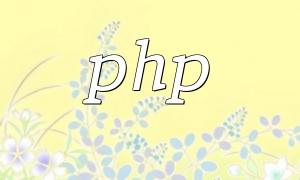PHP is a widely used scripting language that helps make code more modular and manageable through the use of functions. Before using PHP functions, we need to initialize them.
To initialize a PHP function, you must use the `function` keyword, followed by the function name and parentheses. Parameters can be defined inside the parentheses.
function functionName($parameter1, $parameter2, $parameter3) {
// function body
}
When initializing a function, you define the function's parameters, which can be used within the function body. The function body can also contain logic, conditional statements, and other code.
PHP functions support nesting, allowing you to call one function from within another. This improves code organization and increases the reusability of the code.
For example, we can define a simple function to add two numbers:
function add($num1, $num2) {
return $num1 + $num2;
}
Then, we can call this `add()` function within another function to perform the calculation:
function calculateSum($num1, $num2, $num3) {
$sum = add($num1, $num2);
return add($sum, $num3);
}
In the code above, the `calculateSum()` function first calls the `add()` function to calculate the sum of `$num1` and `$num2`. It then adds the result to `$num3` and returns the final sum.
PHP includes a wide range of built-in functions for performing common tasks such as string manipulation, array operations, file handling, and more.
This function is used to get the length of a string:
$string = "Hello World!"; $length = strlen($string); echo "The length of the string is: " . $length;
The above code will output: The length of the string is: 12
This function is used to extract a substring from a string:
$string = "Hello World!"; $substring = substr($string, 0, 5); echo "The extracted substring is: " . $substring;
The above code will output: The extracted substring is: Hello
In addition to string functions, PHP also provides many other built-in functions, such as array-related functions (`array_push()`, `array_pop()`) and file handling functions (`file_get_contents()`, `file_put_contents()`). These built-in functions greatly improve development efficiency, allowing developers to perform common tasks quickly.
In conclusion, initializing and nesting functions in PHP are fundamental aspects of using functions effectively. By defining and calling functions appropriately, you can improve code modularity and reusability. Additionally, PHP provides a rich set of built-in functions that help developers quickly accomplish various tasks. In real-world development, we should fully leverage the features of PHP functions, organizing and using them properly to enhance code readability and maintainability.









